PORTUGUESE TRAVELERS AND CURRENTS ON THE ATLANTIC OCEAN - PART I
![]()
Real seaman and professional navigator must learn something at the result of previous travels. If Duarte Pereira would use Canary and North Passat currents, he could repeat van Olmen’s mistake. But it was winter in the northern hemisphere when he started his travel. It was better to use alternative currents in order to avoid hurricanes and to try not to meet with vessels sailing under the flag of Spain.
The most convenient current for sailing towards the west in the middle of the ocean was West Passat. Because the mentioned current starts in coasts of the gulf of Guinea between 10 north latitude and 20-30 south latitude (width of the current is 300-350 km there) and its width increases when extends towards the west. Broadening ocean river covers the territory between 20 north latitude and 50 south latitude in the Cape Palmas. Width of the current became 80-90 (800-900 km) at 100 west longitude. The current have a branch moving towards the north-west in the west of the Ferro Island and its width extends to the coast of 200 or 300 east latitude. The South Passat has two branches near the San Roka Cape on Brazilian coasts – Guiana current moving towards the north to the Caribbean basin and Brazilian current extending towards the south to South Winds.
The speed of this current moving from Africa to South American coasts isn’t constant: it is 40-50 km in a day at the beginning, 80-120 km on the meridian of the Cape Palmas (in summer), 60 km at 100 west longitude, but sometimes it may be 110 km a day.
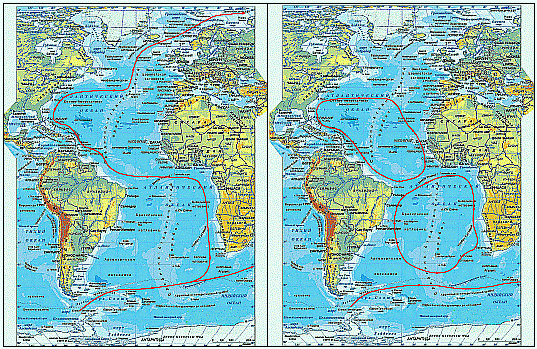 Currents in the Atlantic Ocean
Probably, Duarte Pereira entered the South Passat current near the entry of Guinean coasts and sailed towards Brazilian coasts. He couldn’t impede the ocean river, which took the expedition to the considered point. Pereira drew outlines of that coast line as a cartographer and determined coordinates of that place. He returned back without wasting time. Hastiness didn’t let him complete his work.
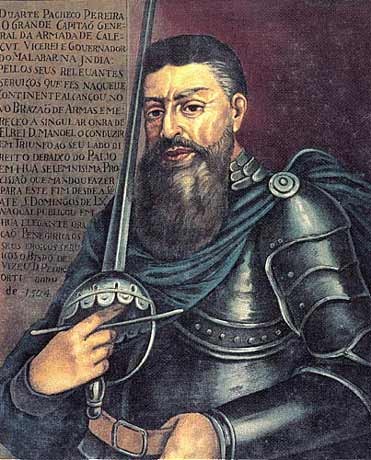 Duarte Pacheco Pereira (1469-1533)
Duarte Pacheco Pereira (1469-1533)
To my mind, one of main tasks of the secret expedition sent by the king Juan II to the western part of the ocean was to return to the motherland as soon as needed lands are discovered. This task was fulfilled. Members of the expedition might lose a month if they tried to get water and to repair the vessel. That’s why old mistake was repeated after six years during the travel of Pedro Cabral.
What was that mistake? As exploration of discovered lands demanded waste of time, it didn’t correspond to the king’s task. Portuguese seamen had to leave mentioned coasts as soon as the land was discovered. That’s why Duarte Pereira thought that, he had discovered an island besides a continent as he hadn’t time to check the coast line. Christopher Columbus also declared that, he had discovered a group of islands after his first travel. Cabral also thought that, the territory discovered by him was a large island when he saw it for the first time.
In spite of all these, Duarte Pereira returned to Lisbon in the first quarter of 1494. Every detail of the prepared report was checked seriously. All distances between Lisbon, remote western coast of Africa, Madeira and Green Cape Islands and Brazilian coasts were fixed in the report. Special attention was paid to coordinates of the discovered territory. I looked through some versions of coordinates and came to the following conclusion: Pereira had reached Brazilian coasts at 10 south latitude and 420-430 west longitude in the territory of San-Luis and Belen. As the coast line is cracked in that territory and the territory of San-Luis is situated on the peninsula, the seaman thought that, he had met with a group of islands.
You may ask why I emphasize that, Duarte Pereira reached the territory of today’s San-Luis. I think that, Pereira sailed towards the west by means of the South Passat current near Guinean coasts and met with Guiana and Brazilian currents in the threshold of South America. As the Guinea current moving towards the north rose to latitudes of the Pyrenean peninsula, Pereira chose that current and sailed to 10 south latitude. It was easier to return to Europe from that latitude without wasting time.
Though Christopher Columbus’s report of coordinates had been coded, Portuguese presumably knew that, Spaniards had met with lands at 500 west longitude. Duarte Pereira wasn’t interested in latitudes before the beginning of 1494. Two factors played important role in this problem. First, Spaniards mightn’t carry out exploration below the 28th parallel of the northern hemisphere according to the treaty of Alcasovas. Otherwise, made discoveries wouldn’t have any juridical basis. Second, Duarte Pereira decided to use the South Passat moving towards the west below the equator as he had to fulfill the king’s task in winter. Owing to it, Portuguese achieved their goals. But they couldn’t even imagine that, the territory they had discovered was a continent.
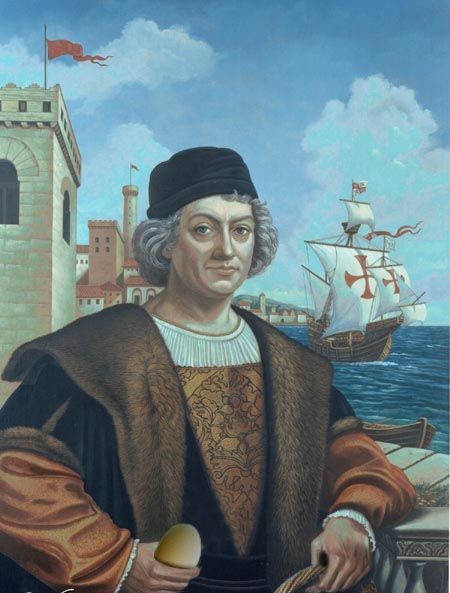 Christopher Columbus (1451-1506)
Christopher Columbus (1451-1506)
The expedition organized in accordance with the order of the king Manuel I after six years, sailed from Green Cape Islands towards the south under the leadership of Pedro Cabral. They sailed towards the west by means of the South Passat current and approached the coast line by means of the Brazilian current blowing towards the south. Pereira’s efforts are matchless in this business. But participation of experienced seamen might reveal secret of the expedition. As Bartolommeo Dias knew the Atlantic Ocean, it was impossible to convince him of the lie about losing way in the ocean. But in spite of all these, though Bartolommeo Dias had understood the ruse, he took this secret to the bottom of the ocean.
The most experienced, the most skilful and well-known seamen of the Pyrenean peninsula Bartolommeo Dias and Duarte Pereira were members of Cabral’s expedition. So they couldn’t lose way in stormy weathers. Those persons knew the eastern part of the Atlantic Ocean very well and were graduates of the most authoritative navigation school. Besides it, they were close friends as B. Dias had rescued Pereira, who had met an accident when returned to Lisbon after the discovery of the Cape of Good Hope.
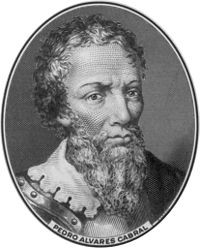 Pedro Alvaresh Cabral (1467-1520)
Pedro Alvaresh Cabral (1467-1520)
The difference between them was as following: Bartolommeo Dias knew western coasts of Africa located between north and south, but Pereira knew islands and archipelagos located in the Atlantic Ocean, which were known for Portuguese seamen. As he knew places of archipelagos and currents very well, he had to be entrusted with the discovery of Brazil. That expedition hadn’t to fail as expeditions of Vogado, Telles, van Olmen and others.
But Pedro Cabral’s expedition to India was the last travel for Bartolommeo Dias, who had discovered the Cape of Good Hope for Europeans. According to historical sources, the expedition met with strong hurricane at the end of May when it left Brazilian coasts and reached the Cape of Good Hope. At the result of it, four vessels of the expedition went down the ocean. B. Dias died on that tragic day.
One of persons, who knew secrets of Brazil’s enigmatic discovery – annalist of the expedition Pero Vaz de Caminha also died during that travel. He was killed together with 50 members of the expedition when indigenous population attacked Portuguese in Calicut. Main witnesses took secrets of Brazil’s discovery to the life hereafter. It corresponded to the Portugal king’s interests.
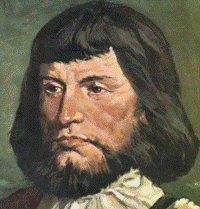 Pero Vaz de Caminha (1450-1500)
Pero Vaz de Caminha (1450-1500)
In a word, the Portugal kingdom could appropriate very large territory owing to Duarte Pereira. Nevertheless, if that expedition resulted in failure as previous travels, they had to be satisfied with islands discovered in the Atlantic Ocean.
Portuguese, who had enough necessary information, demanded to move the demarcation line towards 500 west longitude in order to ensure fair division as if they didn’t know anything about existence of Brazil. At that time almost everybody was sure that the earth’s surface was straight. Portuguese knew that, this factor had to be taken into consideration in order to swindle the Pope by basing on the treaty of Tordesillas. As the earth’s surface was considered straight, all territories extended from the west of the demarcation line to the east had to be Portuguese’s property.
(Continue of article: “Activities of Duarte Pacheco Pereira and Christopher Columbus”)
Best regards, the member of Azerbaijan Geographic Society,
President grant holder on literature, laureate of the “Golden pen” award,
writer/ investigator Ramiz Daniz
 25911
|
FOLLOW US

CALENDAR
GEOGRAPHICAL TERMS


|